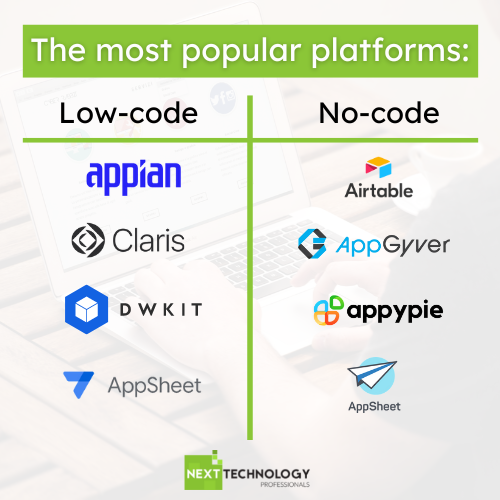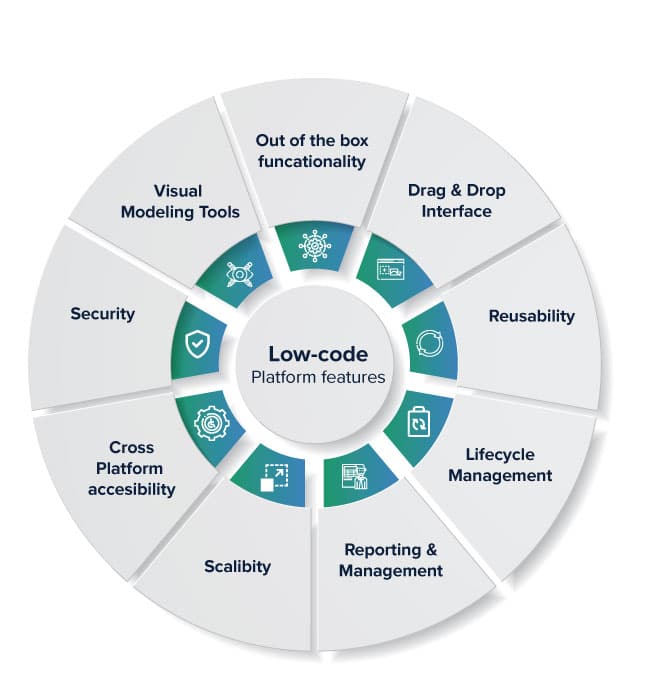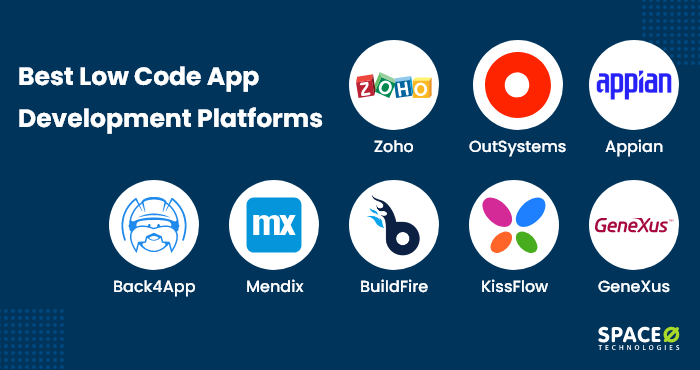Good News To Choosing application development with Low-code platforms
Good News To Choosing application development with Low-code platforms
Blog Article
In Terms Of Integration Capabilities, Low-Code Applications Development Has Many Advantages.
Low-code development of applications offers huge advantages in the area of integration capabilities. These are vital for developing applications that are able to seamlessly connect to diverse platforms and services. Here are a few of the main advantages: Prebuilt Connectors and APIs
Wide Range of Connectors Low-code platforms usually come with a vast library of connectors that are pre-built for popular enterprise software (e.g., ERP, CRM, databases, cloud services). This makes it easier to integrate with systems.
API Integration: Many low code platforms come with out-of the-box integration API capabilities that allow developers to connect easily with external services and sources of data.
Easy to Use:
Drag-and-Drop Integration: Many integration tasks can be completed by using drag-and-drop interfaces. This allows developers and nondevelopers to create complex integrations with little or no programming.
Visual Workflow Builders Visual tools to design workflows and data flow aid in understanding and establishing integrations with greater ease.
Standardized Integration Methods:
SOAP and restful services that support web-based services standard protocols such as REST and SOAP allows integration with a many different platforms and systems.
OData and other Standards Support for other standards like OData provides easy access to and manipulation of data on different platforms and software.
Real-Time Data Synchronization:
Real-Time Integrations: Low-code platforms can handle real-time data sync between applications and systems. This ensures that data is always up-to-date and synchronized across the company.
Event-Driven Architect: A few platforms come with structures that are event driven, allowing applications to respond instantly to any event. This is crucial in dynamic interactive applications.
Legacy System Integration:
Connecting old and new Systems: Low-code platforms often include tools for integration with older systems, allowing companies to modernize their IT infrastructure without radically overhauling the existing system.
Data Migration Tools - Built-in data migration tools allow you to transfer data from older systems to lower-code applications.
Integration of Third Party Services:
Cloud Services: Seamless Integration with Cloud Services such as AWS Azure Google Cloud and Google Cloud makes it easy to deploy applications.
Business Applications Integration: Low code platforms are able to be integrated with other business software like Salesforce, SAP and Microsoft Dynamics. This allows for a seamless workflow between business functions.
Simplified Data Management:
Data models that are unifying: Some platforms that offer low-code support for unified models of data to simplify data management across different systems.
Data Connectors: These pre-configured data connectors permit easy access to and manipulation of data from diverse sources.
Security and compliance
Low-code integration platforms meet security standards to protect information while it is in transit or in storage.
Features for Compliance - These platforms include features to ensure the integrations are compliant with the regulatory requirements.
Extensibility:
Custom Code and Scripts: To meet more complex integration needs Low-code platforms typically permit the integration of custom scripts and code that allow for flexibility, without compromising ease of use.
Plug-in Ecosystems : An eco system of extensions and plugins allow users to increase the possibilities of integration. They can include new features as they need.
In the end, the integration capabilities of low-code development platforms makes them a powerful device for building connected, efficient and scalable apps. They simplify the process of connecting different systems, improve the flow of data and enable companies to take advantage of new technologies while leveraging existing ones. Have a look at the most popular Low-code Platform for application development for site examples including jdbc server, low code platforms, jdbc server, mobile app development platforms, lowcode no code, mobile development platforms, sso azure, app modernization, low code development platforms, cross platform mobile development and more.
Low-Code Application Development Offers Numerous Benefits, Particularly In Terms Of Cost-Effectiveness.
Low-code development offers a number of advantages when it comes to cost-effectiveness. Businesses trying to cut costs can benefit from this option while delivering quality applications. Below are some of the main advantages.
Less Coding Requirements: The low codes platforms remove the requirement for complex, hand-coded applications. Developers are able to take less time and energy creating applications. This translates into lower costs for labor.
We need fewer resources for developers: Programming with low-code is more efficient and quicker which means that fewer developers with specialized skills are needed. This could drastically cut costs for hiring and staffing.
Faster time to market
Accelerated Development: Low-code platforms provide visual development tools, pre-built components and other features that enable rapid development of applications. Businesses can bring their products to market more quickly. This could lead to quicker revenue generation and better competitive positioning.
Rapid Prototyping. Businesses can rapidly test and develop prototypes. This reduces time spent in the development process and allows for quicker iterations dependent on the feedback of users.
Reduce Maintenance Costs
Due to their modularity and standard components, apps built on low-code platforms are simpler to maintain. This helps reduce maintenance and support cost.
Automated Patches and Updates: Low-code platforms can manage updating and patching applications automatically. This guarantees that your application remains secure and always up-to-date without extensive manual intervention.
Efficient Resource Utilization:
Non-Developer contributions: Low code platforms empower non-developers, like business users, to be a part of the process of development. This allows companies to use the skills of many employees and reduce their dependence on highly paid programmers.
Optimized use of IT resources: IT departments have the chance to concentrate on more strategic projects, instead of being sucked into simple work tasks for development. Overall productivity and efficiency improves.
Price models that can be scaled:
Subscription-Based Price: Many low-code platforms have flexible subscription-based pricing that scales according to use. This allows businesses the ability to match their spending to their growth and needs, without incurring large upfront costs.
Pay-Asyou-Go Options Certain platforms allow businesses to pay only for the amount they spend. This is particularly beneficial for small or start-up companies with limited funds.
Reduction in Third-Party Software Fees:
Low-code platforms are often equipped with integrated functions that eliminate the need to purchase extra tools or software. This can save you money on subscriptions and licensing costs.
Pre-Built Integrations: The existence of pre-built integrations with popular services and systems minimizes the requirement for custom development, which saves both time and money.
ROI Boosted
Increased Return on Investment: Combining rapid development with lower costs and a faster time to market, businesses can achieve an increased return on their investments (ROI).
Enhanced Agility - Businesses are able to quickly adapt to changes in market and changing customer needs. This helps them remain relevant and to take advantage of opportunities that arise.
Low-cost Training:
User-Friendly Interfaces: Low-code platforms offer intuitive and easy-to-use interfaces that reduce the learning curve.
Accessible Resources A lot of low-code platforms provide complete training materials, tutorials, as well as community support, reducing the requirement for formal education and the associated cost.
Collaboration is streamlined:
Enhanced collaboration tools Collaboration tools are integrated into the workflow. This allows more effective communication between team members and an improvement in overhead for projects.
Unified Development Environment. A single unifying software development environment could streamline processes and cut down on the cost and complexity of managing different software and platforms.
Overall, the cost effectiveness of low-code software development can be attributed to its ability to lower the cost of maintenance and development as well as increase the time to market as well as optimize the use of resources and also provide flexible pricing models. This mix of elements gives firms significant financial benefits which makes Low-code a desirable option for businesses looking to increase their development budgets while still achieving robust and flexible applications. Check out the recommended Legacy application modernization with Low-code blog for more recommendations including stored sql procedures, application modernization, push notifications, app modernisation, app dev platform, push notifications android, develop cross platform mobile app, app modernization, low code platforms, low code development platforms and more.
Benefits Of Low-Code Application Development In Terms Of Community Support And Vendor Support
Low-code platforms offer significant advantages in terms of community support and vendor support Both of which are crucial to the success in the implementation, maintenance, and further improvement of software. These are the main benefits:Vendor support
Comprehensive Technical Support:
Support Teams: Many platforms that use low-code provide special support teams that assist with technical problems, troubleshooting and guidance.
24/7 Support: Some vendors are available 24/7 and this is helpful for businesses that operate in multiple time zones.
Training and Onboarding
Formal Training Programs: Many vendors provide a structured and organized training program, including tutorials, webinars and courses for certification, to assist users in getting up to speed with the platform quickly.
Many companies offer customized onboarding that helps customers to utilize the platform effectively and tailor it to the needs of their customers.
Regular Updates, Enhancements and Improvements:
Continuous Improvement Lowcode platform providers typically issue regular updates that include new features, improvements to performance and security patches. This ensures that the platform stays up-to date and secure.
Feedback integration: Vendors will frequently incorporate feedback from users during their process of development to ensure that the platform is able to meet the changing requirements of users.
Comprehensive Documentation:
Comprehensive Documentation: A comprehensive and well-organized documentation is usually available, covering everything from basics to advanced customization, which allows users to solve problems on their own.
API References: Comprehensive API documentation helps developers integrate the low-code platform with other systems and customize their applications effectively.
Professional Consulting Services
Expert Consulting : Vendors provide consultancy services, including the design of architectures and complicated implementations. They offer this service in order to make sure that their users are able take full advantage of the platform.
Custom Development Service: Certain vendors offer custom development to build functionalities or integrates for their clients that are not easily available.
Community Support for the Community
Active User Communities:
Discussion boards and forums Forums and Discussion boards: Many low-code platforms provide lively online communities that allow users to exchange ideas, ask questions and collaborate.
User Groups and Meetings Local and virtual user groups and meetups offer opportunities to learn about, network, and share experiences with others.
Knowledge sharing and collaboration
Community-Contributed Resources: Users often share templates, modules, and extensions that they have developed, which can be reused or adapted by others, accelerating development and innovation.
Crowdsourced problem solving: The collective experience and knowledge of the community is an excellent resource when it comes to tackling issues and coming up with creative solutions.
Learning and Development
Community-Led Training: Many communities host workshops, training sessions and webinars. These are usually conducted by experienced users who offer practical tips as well as advanced techniques.
Online Courses and Tutorials: Community members frequently create and share online courses, tutorials, and guides on how-to, which enhance the educational resources that are available to all users.
Feedback and Influence
Product Feedback: Several community forums allow users to provide feedback to vendors. This can influence the design of new features or improvements.
Beta Testing Programs - Active members of the community may be able to take part in the beta testing program. This will give them the chance to see first-hand new features and also the chance to influence the evolution of the system.
Recognition and Encouragement
A lot of vendors have community recognition programs, like MVP programs (Most Valuable Professional) to acknowledge the contributions of members who are involved in their communities.
Peer Support Community members frequently offer support to peers through sharing their knowledge and offering guidance to users who are less experienced. This helps create a more collaborative friendly and supportive environment.
The combination of solid vendor support, as well as an engaged, active community creates a broad ecosystem of support for low-code development. It makes sure that users have access to the expertise, resources and collaboration opportunities, they need to successfully develop and launch their applications.